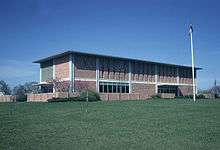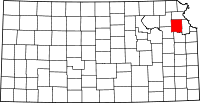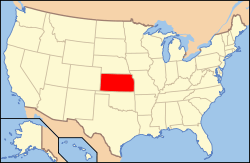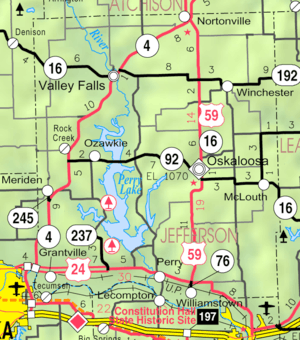Jefferson County, Kansas
| Jefferson County, Kansas | |
|---|---|
| County | |
 Jefferson County Courthouse in Oskaloosa | |
 Location in the U.S. state of Kansas | |
 Kansas's location in the U.S. | |
| Founded | August 25, 1855 |
| Named for | Thomas Jefferson |
| Seat | Oskaloosa |
| Largest city | Valley Falls |
| Area | |
| • Total | 557 sq mi (1,443 km2) |
| • Land | 533 sq mi (1,380 km2) |
| • Water | 24 sq mi (62 km2), 4.3% |
| Population (est.) | |
| • (2012) | 18,945 |
| • Density | 36/sq mi (14/km²) |
| Congressional district | 2nd |
| Time zone | Central: UTC-6/-5 |
| Website |
jfcountyks |
Coordinates: 39°13′N 95°24′W / 39.217°N 95.400°W
Jefferson County (county code JF) is a county located in the U.S. state of Kansas. At the 2010 census, the county population was 19,126.[1] Its county seat is Oskaloosa,[2] and its most populous city is Valley Falls.
History
Early history
For many millennia, the Great Plains of North America was inhabited by nomadic Native Americans. From the 16th century to 18th century, the Kingdom of France claimed ownership of large parts of North America. In 1762, after the French and Indian War, France secretly ceded New France to Spain, per the Treaty of Fontainebleau.
19th century
In 1802, Spain returned most of the land to France, but keeping title to about 7,500 square miles. In 1803, most of the land for modern day Kansas was acquired by the United States from France as part of the 828,000 square mile Louisiana Purchase for 2.83 cents per acre.
In 1854, the Kansas Territory was organized, then in 1861 Kansas became the 34th U.S. state. In 1855, Jefferson County was established, and was named for President Thomas Jefferson.[3] Settlement of the county was slowed by events prior to and during the Civil War, but the present day unincorporated community of Thompsonville (3 miles northwest of Perry on the Delaware River) was the first established in 1851 by Mormon settlers who initially refused to accompany the main group led by Brigham Young to the Salt Lake Valley. The settlement was first abandoned due to the violence resulting from the border wars, but was re-established when the Civil War ended.
Geography
According to the U.S. Census Bureau, the county has a total area of 557 square miles (1,440 km2), of which 533 square miles (1,380 km2) is land and 2.4 square miles (6.2 km2) (4.3%) is water.[4]
Adjacent counties
- Atchison County (north)
- Leavenworth County (east)
- Douglas County (south)
- Shawnee County (southwest)
- Jackson County (northwest)
Demographics
| Historical population | |||
|---|---|---|---|
| Census | Pop. | %± | |
| 1860 | 4,459 | — | |
| 1870 | 12,526 | 180.9% | |
| 1880 | 15,563 | 24.2% | |
| 1890 | 16,620 | 6.8% | |
| 1900 | 17,533 | 5.5% | |
| 1910 | 15,826 | −9.7% | |
| 1920 | 14,750 | −6.8% | |
| 1930 | 14,129 | −4.2% | |
| 1940 | 12,718 | −10.0% | |
| 1950 | 11,084 | −12.8% | |
| 1960 | 11,252 | 1.5% | |
| 1970 | 11,945 | 6.2% | |
| 1980 | 15,207 | 27.3% | |
| 1990 | 15,905 | 4.6% | |
| 2000 | 18,426 | 15.9% | |
| 2010 | 19,126 | 3.8% | |
| Est. 2015 | 18,930 | [5] | −1.0% |
| U.S. Decennial Census[6] 1790-1960[7] 1900-1990[8] 1990-2000[9] 2010-2013[1] | |||
Jefferson County is included in the Topeka, KS Metropolitan Statistical Area.
At the 2000 Census, there were 18,426 people, 6,830 households and 5,190 families residing in the county. The population density was 34 per square mile (13/km²). There were 7,491 housing units at an average density of 14 per square mile (5/km²). The racial makeup of the county was 96.70% White, 0.92% Native American, 0.37% Black or African American, 0.17% Asian, 0.01% Pacific Islander, 0.42% from other races, and 1.41% from two or more races. Hispanic or Latino of any race were 1.28% of the population.
There were 6,830 households of which 35.70% had children under the age of 18 living with them, 65.20% were married couples living together, 7.00% had a female householder with no husband present, and 24.00% were non-families. 20.10% of all households were made up of individuals and 9.30% had someone living alone who was 65 years of age or older. The average household size was 2.66 and the average family size was 3.07.
27.40% of the population were under the age of 18, 7.00% from 18 to 24, 28.00% from 25 to 44, 24.90% from 45 to 64, and 12.80% who were 65 years of age or older. The median age was 38 years. For every 100 females there were 102.60 males. For every 100 females age 18 and over, there were 98.90 males.
The median household income was $45,535 and the median family income was $50,557. Males had a median income of $36,174 compared with $25,468 for females. The per capita income for the county was $19,373. About 5.30% of families and 6.70% of the population were below the poverty line, including 6.90% of those under age 18 and 7.70% of those age 65 or over.
Law and government
Jefferson County was a prohibition, or "dry", county until the Kansas Constitution was amended in 1986 and voters approved the sale of alcoholic liquor by the individual drink with a 30% food sales requirement.[10]
Education
Unified school districts
- Valley Falls USD 338
- Jefferson County North USD 339
- Jefferson West USD 340
- Oskaloosa USD 341
- McLouth USD 342
- Perry-Lecompton USD 343
Communities

Cities
Unincorporated communities
- Boyle
- Buck Creek
- Dunavant
- Grantville
- Lakeside Village
- Half Mound
- Indian Ridge
- Lake Shore
- Medina
- Mooney Creek
- Newman
- Rock Creek
- Thompsonville
- West Shore
- Williamstown
Townships
Jefferson County is divided into twelve townships. None of the cities within the county are considered governmentally independent, and all figures for the townships include those of the cities. In the following table, the population center is the largest city (or cities) included in that township's population total, if it is of a significant size.
See also
|
|
References
- 1 2 "State & County QuickFacts". United States Census Bureau. Retrieved July 26, 2014.
- ↑ "Find a County". National Association of Counties. Retrieved 2011-06-07.
- ↑ Gannett, Henry (1905). The Origin of Certain Place Names in the United States. Govt. Print. Off. p. 168.
- ↑ "US Gazetteer files: 2010, 2000, and 1990". United States Census Bureau. 2011-02-12. Retrieved 2011-04-23.
- ↑ "County Totals Dataset: Population, Population Change and Estimated Components of Population Change: April 1, 2010 to July 1, 2015". Retrieved July 2, 2016.
- ↑ "U.S. Decennial Census". United States Census Bureau. Retrieved July 26, 2014.
- ↑ "Historical Census Browser". University of Virginia Library. Retrieved July 26, 2014.
- ↑ "Population of Counties by Decennial Census: 1900 to 1990". United States Census Bureau. Retrieved July 26, 2014.
- ↑ "Census 2000 PHC-T-4. Ranking Tables for Counties: 1990 and 2000" (PDF). United States Census Bureau. Retrieved July 26, 2014.
- ↑ "Map of Wet and Dry Counties". Alcoholic Beverage Control, Kansas Department of Revenue. November 2006. Retrieved 2007-12-28.
Further reading
- History of the State of Kansas; William G. Cutler; A.T. Andreas Publisher; 1883. (Online HTML eBook)
- Kansas : A Cyclopedia of State History, Embracing Events, Institutions, Industries, Counties, Cities, Towns, Prominent Persons, Etc; 3 Volumes; Frank W. Blackmar; Standard Publishing Co; 944 / 955 / 824 pages; 1912. (Volume1 - Download 54MB PDF eBook),(Volume2 - Download 53MB PDF eBook), (Volume3 - Download 33MB PDF eBook)
External links
| Wikimedia Commons has media related to Jefferson County, Kansas. |
- County
- Jefferson County - Official
- Jefferson County - Directory of Public Officials
- Jefferson County - Economic Development Commission
- Maps
- Jefferson County Maps: Current, Historic, KDOT
- Kansas Highway Maps: Current, Historic, KDOT
- Kansas Railroad Maps: Current, 1996, 1915, KDOT and Kansas Historical Society
 |
Jackson County | Atchison County |  | |
| |
Leavenworth County | |||
| ||||
| | ||||
| Shawnee County | Douglas County |

